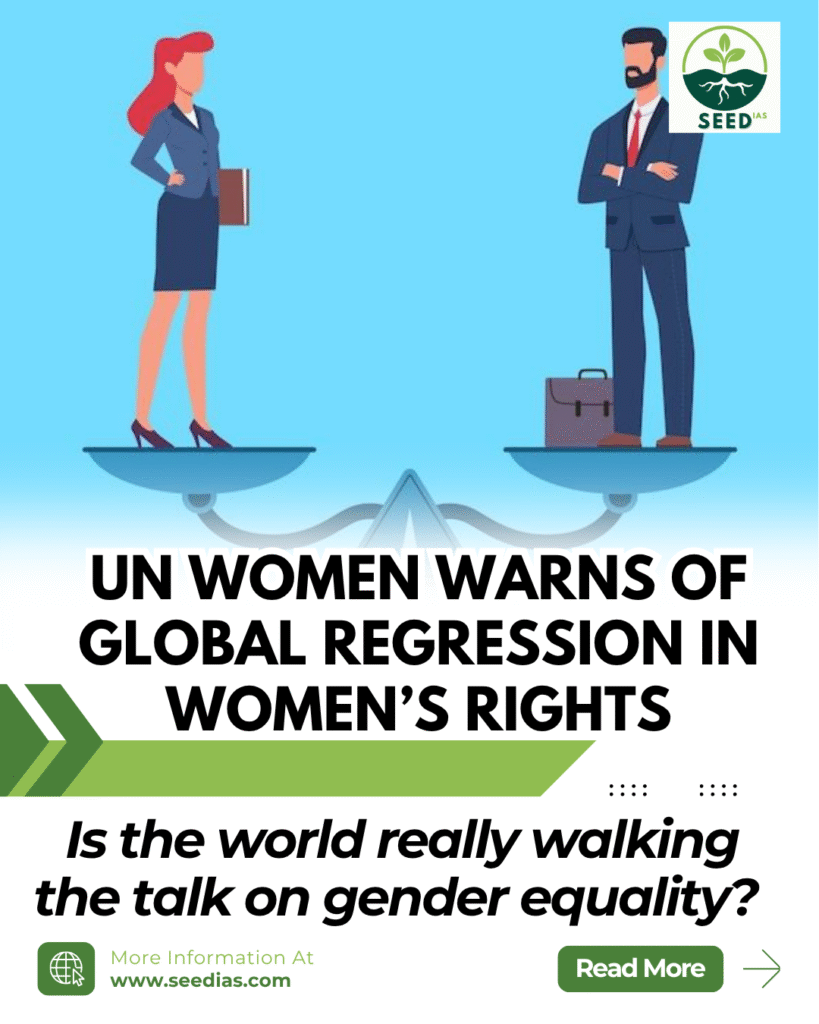Why in NEWS
Marking the 30th anniversary of the Beijing Declaration, 25 years of UNSC Resolution 1325, and UN Women’s 15th year, the UN has sounded alarm over a growing backlash against women’s rights, deepening gender inequality, and widespread violence and exclusion.
Key Terms & Concepts
| Term | Explanation |
|---|---|
| Beijing Declaration (1995) | Landmark global blueprint for advancing women’s rights adopted at the 4th World Conference on Women. |
| UNSC Resolution 1325 | A UN resolution calling for women’s participation in peace and security processes and protection during conflicts. |
| UN Women | UN entity founded in 2010 to promote gender equality and women’s empowerment worldwide. |
| FLFPR | Female Labour Force Participation Rate – measures the share of working-age women who are employed or seeking work. |
| Digital Divide | The gap in access to digital tools and internet connectivity between different groups, especially women and men. |
Key Issues Faced by Women (Global & India)
| Area | Issue |
|---|---|
| Political Representation | Women hold only 64% of the rights men have; 75% of lawmakers are men. Only 4% of global aid targets gender equality. |
| Violence | 85,000 women killed in 2023—one every 10 minutes—often by intimate partners or family members. |
| Economic Disparity | Women earn 20% less globally; perform 2.5x more unpaid care work. In India, women earn 29–51% less than men. |
| Food & Education | 47.8 million more women face food insecurity; 119 million girls remain out of school globally. |
| Climate Inequity | Climate change could push 158 million more women into extreme poverty by 2050. |
| Health Access | 800 preventable maternal deaths occur daily. In conflict zones, women lack basic reproductive healthcare. |
| Digital Inequality (India) | Only 54% of Indian women own mobile phones, vs 82% of men; only 33% use the internet. |
| Violence in India | 4.4 lakh cases of crimes against women reported in 2022; nearly 30% of married women faced spousal violence. |
Beijing Declaration and Platform for Action (1995)
| Feature | Details |
|---|---|
| About | Adopted at the 4th UN World Conference on Women in Beijing, China. |
| Significance | Outlines 12 critical areas for achieving gender equality, including education, health, political participation, and eliminating violence. |
| India’s Role | India is a signatory and has aligned several policies with the BPfA. |
| Beijing+30 Agenda | Global review of progress ahead of the 30th anniversary in 2025, focusing on six action areas for accelerated change. |
UN Women: Structure and Mandate
| Aspect | Details |
|---|---|
| Founded | July 2010, merging four UN bodies focused on women’s rights. |
| Core Missions | Promoting governance & leadership, economic empowerment, ending gender-based violence, and advancing women in peace & humanitarian work. |
UNSC Resolution 1325 on Women, Peace, and Security
| Pillars | Focus Areas |
|---|---|
| Participation | Inclusion of women in peacebuilding and conflict resolution. |
| Protection | Safeguards against gender-based and sexual violence in conflict. |
| Prevention | Gender-sensitive conflict prevention strategies. |
| Relief & Recovery | Meeting the specific needs of women and girls in post-conflict rehabilitation. |
Proposed Solutions by UN Women
| Focus Area | Recommendations |
|---|---|
| Political Leadership | Eliminate discriminatory laws; promote women’s leadership, especially in climate governance. |
| Peacebuilding | Ensure women’s roles in peace talks; fund gender-inclusive peace efforts. |
| Economic Empowerment | Implement equal pay laws; invest in paid care systems to generate 300 million jobs by 2035. |
| Social Protection | Offer maternity leave, pensions, food security policies; close gender gaps in wages and agriculture. |
| Education & Tech Access | Reduce education costs; ensure safe learning environments; improve women’s digital access and cybersecurity. |
In a Nutshell
Mnemonic: P-E-A-C-E
Political will, Economic equality, Access to rights, Climate justice, Ending violence
Despite decades of global pledges, gender inequality persists. UN Women’s call to action demands stronger laws, inclusive leadership, tech access, and climate protection to reverse regression and advance women’s rights.
Prelims Practice Questions
- Which of the following global frameworks focuses specifically on women’s role in peace and conflict resolution?
A. CEDAW
B. UNSC Resolution 1325
C. Beijing Declaration
D. SDG 16 - Consider the following pairs:
- Beijing Declaration – 1995
- UN Women – 2000
- UNSC Resolution 1325 – 2000
Which of the pairs are correctly matched?
A. 1 and 2 only
B. 1 and 3 only
C. 2 and 3 only
D. All of the above
- Which of the following is not a core focus area of UN Women?
A. Combatting terrorism
B. Economic empowerment
C. Ending violence against women
D. Gender-inclusive governance
Mains Questions
- Despite progressive frameworks like the Beijing Declaration and UNSC Resolution 1325, women remain excluded from leadership and peacebuilding roles. Examine the causes and suggest solutions. (GS2: International Relations, Governance)
- Discuss the key barriers to digital inclusion for women in India and how bridging the gender digital divide can accelerate women’s empowerment. (GS2: Social Justice)
Prelims Answer Key and Explanations
| Qn | Answer | Explanation |
|---|---|---|
| 1 | B | UNSC Resolution 1325 is dedicated to women, peace, and security. |
| 2 | B | UN Women was established in 2010, not 2000. The other dates are correct. |
| 3 | A | Combatting terrorism is not a direct focus area of UN Women. |
















